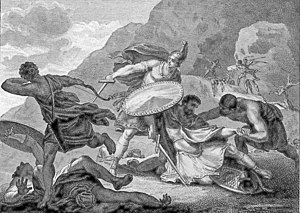
Back معركة تيسينيوس Arabic Битка при Тичино Bulgarian Bitka kod Ticina BS Batalla del Ticino Catalan Gefecht am Ticinus German Batalla del Tesino Spanish نبرد تیچینو Persian Bataille du Tessin French קרב טיקינוס HE Ticinusi csata Hungarian
| Battle of Ticinus | |||||||
|---|---|---|---|---|---|---|---|
| Part of the Second Punic War | |||||||
 Eighteenth-century depiction of the battle, showing the younger Scipio rescuing his wounded father | |||||||
| |||||||
| Belligerents | |||||||
| Carthage | Rome | ||||||
| Commanders and leaders | |||||||
| Hannibal | Publius Scipio (WIA) | ||||||
| Strength | |||||||
| 6,000 cavalry |
3,600 cavalry Up to 4,500 velites Up to 2,000 mounted Gallic infantry | ||||||
| Casualties and losses | |||||||
| Light | Heavy | ||||||
The Battle of Ticinus was fought between the Carthaginian forces of Hannibal and a Roman army under Publius Cornelius Scipio in late November 218 BC as part of the Second Punic War. It took place in the flat country on the right bank of the river Ticinus, to the west of modern Pavia in northern Italy. Hannibal led 6,000 Libyan and Iberian cavalry, while Scipio led 3,600 Roman, Italian and Gallic cavalry and a large but unknown number of light infantry javelinmen.
War had been declared early in 218 BC over perceived infringements of Roman prerogatives in Iberia (modern Spain and Portugal) by Hannibal. Hannibal had gathered a large army, marched out of Iberia, through Gaul (modern France) and over the Alps into Cisalpine Gaul (northern Italy), where many of the local tribes were opposed to Rome. The Romans were taken by surprise, but one of the consuls for the year, Scipio, led an army along the north bank of the Po with the intention of giving battle to Hannibal. The two commanding generals each led out strong forces to reconnoitre their opponents. Scipio mixed many javelinmen with his main cavalry force, anticipating a large-scale skirmish. Hannibal put his close-order cavalry in the centre of his line, with his light Numidian cavalry on the wings.
On sighting the Roman infantry the Carthaginian centre immediately charged and the javelinmen fled back through the ranks of their cavalry. A large cavalry melee ensued: many cavalry dismounted to fight on foot and some of the Roman javelinmen reinforced the fighting line. This continued indecisively until the Numidians swept round both ends of the line of battle. They then attacked the still disorganised javelinmen; the small Roman cavalry reserve, to which Scipio had attached himself; and the rear of the already engaged Roman cavalry. All three of these Roman forces were thrown into confusion and panic.
The Romans broke and fled, with heavy casualties. Scipio was wounded and only saved from death or capture by his 16-year-old son. That night Scipio broke camp and retreated over the Ticinus; the Carthaginians captured 600 of his rearguard the next day. After further manoeuvres Scipio established himself in a fortified camp to await reinforcements while Hannibal recruited among the local Gauls. When the Roman reinforcements arrived in December under Tiberius Longus, Hannibal heavily defeated him at the battle of the Trebia. The following spring, strongly reinforced by Gallic tribesmen, the Carthaginians moved south into Roman Italy. Hannibal campaigned in southern Italy for the next 12 years.